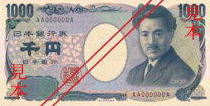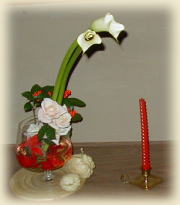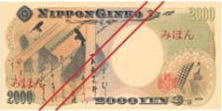Hi, friends. This is Christmas again.
My small Christmas gift is MONEY this year.
I hope you like MONEY !
In November this year, Japanese Government issued three new designs of
banknotes. 10000yen, 5000yen, and 1000yen bills to prevent forgery. And
that stimulated my curiosity.
I have not paid much interest in the faces on the bills. Suddenly I noticed
I should respect them properly, at least as much as I respect the value
of the currency. If I grow friendship with those characters and show more
hospitality, they might stay with me longer. I now know that because I
was not kind enough to them, they left me all too soon!
So I will introduce you the people on Japanese banknotes. You can say hello
or goodbye to them when they come and go.
Please enjoy meeting the personalities on Japanese money.
I will borrow the information from many web-sites written in English like
Wikipedia. They are quite interesting, with so many links like a huge cobweb.
Don't get captured in the web, though.
10000yen bill
Fukuzawa Yukichi
Fukuzawa Yukichi (Fukuzawa Yukichi, January 10, 1835 - February 3, 1901) was an author, motivational speaker, and political
theorist whose enlightened ideas about government and social institutions made a
lasting impression on a rapidly changing Japan during the period known as the Meiji Era.
Early life
Fukuzawa was born into a low-ranking samurai family in Osaka in 1835. He was not educated during his youth, as
his family was poor following the death of his father. At the age of fourteen,
Fukuzawa finally had enough money to enter a school of Dutch studies. In 1853, shortly after Commodore Matthew C. Perry's
arrival in Japan, Fukuzawa's brother (the family patriarch) asked Fukuzawa to
travel to Nagasaki, where the Dutch
colony at Deshima was located. Fukuzawa was instructed to learn Dutch in order to study
European cannon designs.
Although Fukuzawa did travel to Nagasaki, his stay there was brief as he
quickly discovered that the Dutch scholars there were dealing with outdated
information. He planned to travel to Edo and
continue his studies there, but upon his return to Osaka, his brother persuaded
him to stay and enroll at the Tekijuku school run by physician and Dutch scholar
Ogata Koan. Fukuzawa
studied at Tekijuku for three years, and became fully proficient in the Dutch language. In 1858,
he was appointed official Dutch teacher of his family's domain, Nakatsu, and was sent to Edo to teach the family's vassals there.
The following year, Japan opened up three of its ports to American and
European ships, and Fukuzawa, intrigued with Western civilization, traveled
to Kanagawa to see them. When he
arrived, he discovered that virtually all of the European merchants there were
speaking English.
He then began to study English, but at that time, English-Japanese interpreters
were rare and dictionaries nonexistent, so his studies were slow.
Fukuzawa
Yukichi was a member of the first ever Japanese delegation to the United States,
in 1860. Then, the Edo bakufu decided to send
envoys of the shogun to the United States, and Fukuzawa
volunteered his services to Admiral Kimura
Yoshitake. Kimura's ship, the Kanrin Maru, arrived in
San Francisco, California in 1860, and the delegation stayed in the city for
a month, during which time Fukuzawa had himself photographed with an American
girl (one of the most famous photographs in Japanese history), and also found a
Webster's
Dictionary, from which he began to seriously study the English language.
Fukuzawa became an official translator for the bakufu upon his return.
In 1867, he returned to America, this time visiting Washington, D.C. and New York City as part of a
team of negotiators. After that trip, he visited Europe, again as part of a
negotiation team, and published the first volume of his famous work Seiyo
Jijo ("The West").
Works
Possibly Fukuzawa's writings were his greatest contribution to the Meiji
period. Between 1872 and 1876, he published 17 volumes of Gakumon no
Susume ("An Encouragement of Learning"). In these texts, Fukuzawa outlines
the importance of understanding the principle of equality of opportunity and
that study was the key to greatness. He was an avid supporter of education and
founded one of Japan's most prestigious universities, Keio-gijuku, now known
as Keio
University.
In the volumes of Gakumon no Susume, Fukuzawa advocated his most lasting principle, "national independence through personal independence." Through personal independence, an individual does not have to depend on the strength of another. With such a self-determining social morality, Fukuzawa hoped to instill a sense of personal strength among the people of Japan, and through that personal strength, build a nation to rival all others.
Fukuzawa also published many influential essays and critical works, one of most lasting of which is "Bunmeiron no Gairyaku" ("An Outline of a Theory of Civilization") published in 1875, in which he details his own theory of civilization. According to Fukuzawa, civilization is relative to time and circumstance, as well as comparison. For example, China was relatively civilized in comparison to some of
the Africa colonies, and European nations were the most civilized of all, at the
time.
Fukuzawa was later criticized as a supporter of imperialism because of his essay "Datsu-A Ron"
("Leaving Asia") published in 1885, as well as for his support of the Sino-Japanese War
(1894-1895). Yet, "Datsu-A Ron" was actually a response to a failed attempt
by Koreans to organized an effective reform faction, an attempt he'd supported.
He had invited young Korean aristocrats to his school. Yet, they squandered
their time and money on getting drunk and buying prostitutes and after
Fukuzawa tightened their allowance, they attempted a failed robbery of
school safe. The essay was published as a withdrawal of his support.
His support of the Sino-Japanese War had much to do with his opinions about
modernization. He believed that China
suffered from archaic and unchanging principles. At the time of the war, foot binding was still the practice in China as well as cruel punishments like torture that Japan had already outlawed, opium had been sold on street, and political institutions were failing to fend of foreign incursions and selling interests like railroads and taxation to pay the debt. In his hopes for a strong Japan, Fukuzawa saw the Asian countries around Japan as potential deterrents in need of guidance.
"In my view, these two countries [China and Korea] cannot survive as independent nations with the onslaught of Western civilization to the East. . . It is not different from the case of the righteous man living in a neighborhood of a town known for foolishness, lawlessness, atrocity, and heartlessness. His action is so rare that it is always buries under the ugliness of his neighbors' activities," Fukuzawa wrote in "Datsu-A Ron.
"Fukuzawa's most important contribution to the reformation effort,
though, came in the form of a newspaper called Jiji Shimpo,
which he started in 1882, after being prompted by Inoue
Kaoru, Okuma
Shigenobu, and Ito
Hirobumi to establish a strong influence among the people through
publishing. All agreed the government should take the form of a national
assembly, and as reforms began, Fukuzawa, whose fame was already unquestionable,
began production of Jiji Shimpo, which received wide circulation, encouraging the people to enlighten
themselves and to adopt a moderate political attitude towards the change
that was being engineered within the social and political structures of
Japan.
Legacy
Fukuzawa's ideas about individual strength and his knowledge of western
political theory, as presented in his writings, were instrumental in motivating
the Japanese people to embrace change. He may well have been one of the
most influential personalities in the modernization of Japan.
Today, Fukuzawa appears on the 10,000-yen
banknote.
Further reading
Japan:
A Documentary History (http://www2.chass.ncsu.edu/ambaras/hi233/Readings/Fukuzawa1885.htm)Pride and Independence:
Fukuzawa Yukichi and the Spirit of the Meiji Restoration (http://www.jef.or.jp/en/jti/200305_025.html)
Fukuzawa
biography at UNESCO (PDF) (http://www.ibe.unesco.org/International/Publications/Thinkers/ThinkersPdf/fukuzawe.pdf)
http://www.contemporaryliterature.com/248525_yukichi-fukuzawa.html
|
5000yen bill
Higuchi Ichiyo
Higuchi Ichiyo (, May 2, 1872 - November 23, 1896) is the pen name of the Japanese author Higuchi Natsu ).
Higuchi was born in Tokyo of samurai lineage. In the space of her
short life, she moved a total of 12 times. Upon reaching the age of 14, she
entered the Haginoya, a poetry school; at the age of 15, she suffered the loss of her brother,
and her father's business failed. Shortly afterward, he died and at the
young age of 17 she became the head of the Higuchi household. Along with
her mother and younger sister, they made ends meet by doing needlework,
washing, and other jobs. After seeing the success of a classmate who wrote
a novel, Higuchi decided to become a writer to support her family.
At the age of 20, Higuchi wrote her first novel and also adopted the pen name of Ichiyo. Around this time, Higuchi turned down a marriage proposal (which likely would have signalled the end of her writing career) and moved to a house near the Yoshiwara pleasure quarters. In 1894 her first major work, Ohtugomori was published, and in the following year, Takekurabe , Nigorie, and Jyusanya were published to critical and popular success. Higuchi's literary career
was cut short in 1896, when she contracted, and soon died of, tuberculosis.
In spite of her very short career and limited output, Higuchi is remembered for the quality of her works and is considered to be the first professional female writer in modern Japanese literature. Higuchi's likeness
will adorn the Japanese 5000 yen note starting in the fall of 2004, becoming the second female to appear on a Japanese
banknote since 1881, next to Empress Jingo.
Higuchi's major works include:
|
2000yen bill
Murasaki Shikibu
Murasaki Shikibu was a Novelist, Poet, and servant of the Emperor of Japan
during the Heian Period. She is well known as the author of "The Tale
of Genji", written in Japanese between about 1000 and 1008, one of
the earliest and most famous novels in human history.
Lady Murasaki's mother died while she was a child, so Murasaki was raised, contrary to customs of the time, by her father Tametoki, a scholar and officer of the imperial court. During Heian-era Japan, couples lived separately and children were
raised by the mother and her family. Also contrary to customs of the time,
her father gave her a male's education. Males were educated in and taught
Chinese, the official language of the court,
while females were taught kana and poetry. Her father praised her intelligence
and ability, but lamented she was "born a woman".
At the royal court, she was the lady in waiting for Empress Shoshi/Akiko, and
may have been hired by Fujiwara
Michinaga to serve the Empress.
Three works are attributed to Murasaki, the most important being The Tale of
Genji. The Murasaki Shikibu Diary and
The
Murasaki Shikibu Collection were arranged and published posthumously.
The Murasaki Shikibu Collection was a compilation of 128 poems written by
Murasaki.
Her real name is unknown. Her diary states that she was nicknamed "Murasaki"
at court, after a character in The Tale of Genji. "Shikibu" refers to
her father's position in the Bureau of Ceremony (shikibu-sh?).
.Retrieved from "http://en.wikipedia.org/wiki/Murasaki_Shikibu"
|
1000yen bill
 |
Noguchi Hideyo (1876-1928) is a prominent Japanese bacteriologist who
discovered the agent of syphilis disease in 1911. In 1928, he died while he was working on
yellow fever in Africa.
Noguchi, Hideyo , 1876-1928, Japanese bacteriologist, grad. Tokyo Medical College, 1897.
He came to the United States c.1900 to work with Simon Flexner at the Univ.
of Pennsylvania and in 1904 joined the Rockefeller Institute (now Rockefeller
Univ.) staff. He made important studies of snake venoms, of smallpox and
yellow-fever vaccines, and of the laboratory diagnosis of trachoma. He
isolated (1913) the Treponema
pallidum from a syphilis patient, proving that this spirochete was the cause
of syphilis; he also developed a skin test for syphilis. He died of yellow fever
in Accra, Ghana, where he had been studying that disease. His writings include
Action of Snake Venom upon Cold-Blooded Animals (1904) and Laboratory
Diagnosis of Syphilis (rev. ed. 1923) The Columbia Electronic Encyclopedia, 6th
ed. Copyright c 2004, Columbia University Press.
|
Coins
|
 500yen coin 500yen coin |
Dr. Noguchi's mother Shika was illiterate, which was not unusual in the
poor families at that time.
But while her son was studying abroad, she learned hard, and sent him
many letters. This letter below is written in a mixture of Hiragana and
Katakana, and her yearning to see her son is so touching.
|
(part)
People are amazed with your success. I am so very proud.
In spring, everyone goes to Hokkaido, and I feel lonely. Please come back
soon.
Come back soon, come back soon, come back soon, come back soon, I pray
you. This is my wish once in my life. I pray in the direction of West.
I pray in the direction of East. I pray in the direction of North. I pray
in the direction of South.
Come back soon. Tell me when you come.
I am waiting for your answer. I can not sleep in my sleep.
-written by Shika
Noguchi, in 1912- |
|
|
 100yen coin 100yen coin |
 50yen coin 50yen coin |
 10yen coin 10yen coin |
 5yen coin 5yen coin |
 1yen coin 1yen coin |
You can copy the banknotes for your collection, but if you really use them,
and if you are arrested, never tell the police that Harumi Okochi is behind
you.
I wish you a quiet, peaceful Christmas.
Let us play that we will have a safer world next year.
|







 500yen coin
500yen coin 100yen coin
100yen coin 50yen coin
50yen coin 10yen coin
10yen coin 5yen coin
5yen coin 1yen coin
1yen coin